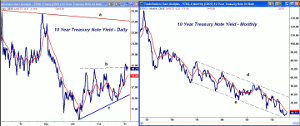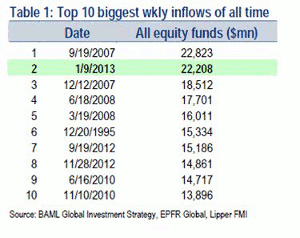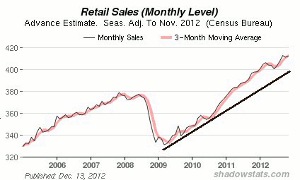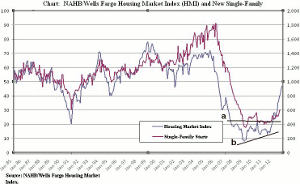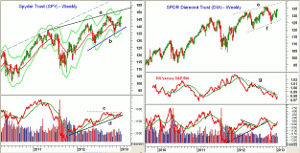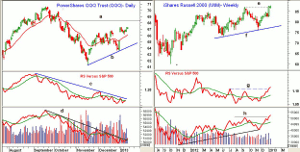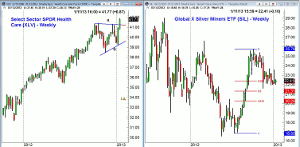The fiscal cliffhanger resolution, coupled with a strong start to earnings season, has fueled a strong stock market rally in the first full trading week of the year. Sectors and other markets are cooking with gas as well—except for one—notes MoneyShow's Tom Aspray.
Stocks surprised the market skeptics last week because while most of the major averages showed little change, the market did not go down as most expected. The standout was the Dow Jones Transportation Average as it moved above the 2012 highs and is close to its all-time highs.
While the early 2013 stock market rally has been impressive the sharp increase in some key interest rates has also caught investors' attention. The yield on the 10-Year T-Note just dropped slightly from the end of 2011 to the 2012 year-end yield of 1.765%.
But there were plenty of wide swings during the year as yields hit a high of 2.34% in March and a low of 1.39% in July. Since early in December, yields have risen from a low of 1.56% to close at 1.87% this week. Is the fat lady now singing that interest rates have bottomed and that bonds are topping out?
The daily chart shows a strong rally from the July lows, line c, and the break through resistance at the September highs (line b). The daily chart reveals quite a bit of resistance between 1.90% and 2.06% from early in 2012 with more important now at 2.31%, line a, which connects the late 2011 and early 2012 highs.
Though one might conclude from this daily chart that rates have bottomed, one must examine the recent action in terms of the long-term yield chart (on the right), which goes back to 1985 when the yield was 13.8%.
Since 1995, yields have been in a pretty well-defined downward channel, line d and e. The yield is still below the 20-month EMA as it has been since May 2011. The EMA is now at 2.01%. From the long-term chart, it would take much higher yields to suggest that this major trend has changed.
Mutual fund data indicates that since the start of 2009 over $1 trillion dollars has moved into bond funds with over $300 billion going into bonds in 2012. This compares with an approximate outflow from stock funds of over $150 billion. In fact, December 2012 was the 20th consecutive month that there were net outflows from stock funds.
There have been several times in the past few years when it looked as though the bond market may have topped. Just a minor outflow of funds from bonds to stocks could cause an explosive stock market rally.
Many bond fund holders only think about the yield not the potential for capital loss in bonds funds. Should they have to face a 10% loss in a bond fund they bought for its 5% yield, their attitudes could change dramatically.
Last week's analysis of the NOB spread, favored by bond professionals suggest they are becoming less bearish on stocks. The data from early 2013 does also suggest investors are becoming a bit more interested in stocks as the $22.2 billion inflow to stocks was the second largest in quite a few years.
NEXT PAGE: What to Watch
|pagebreak|In my pre-Christmas recommendation to Stuff Your Stockings With Stocks, I did point out that often times investors get in too late. Given the technical readings, that may not be the case this time but buying in late December had less risk.
The inflow to stocks and recent uptick in rates is not enough to signal a change in the long-term trend. However the yield on the 10 year T-Note may reach the 2.00% level. It would take a strong move above the 2012 high at 2.34% to suggest that rates had bottomed.
There was little in the way of economic data last week, but this week is a different story. On Tuesday we get the Retails Sales, Producer Price Index and the Empire State Manufacturing Index. The chart of Retail Sales shows that it is in a nice uptrend despite the pessimism over the consumer. The drop in consumer sentiment may cause a lower number for December, but it would not alter the overall trend.
The Empire State Manufacturing Index will be watched more closely as it has been weaker than other surveys recently. On Wednesday, we get Industrial Production, along with the Consumer Price Index and the Housing Index.
As I explained last spring, this index measures the home builders outlook for the economy and overall housing market conditions. As I noted then, it had completed its base formation, lines a and b, which was a positive sign for the homebuilders.
The Housing Starts are also rising nicely and are out on Thursday.
Also Thursday, we get the weekly jobless claims and the Philadelphia Fed Survey. Friday, we will get the first real post-cliff reading on consumer sentiment, which may be revealing.
What to Watch
Even though most of the major averages only
had minor gains last week the market internals continue to reflect a more
healthy market. Therefore, while another day or two of selling is possible, the
S&P 500 is likely to challenge the 1500 level soon with the Dow Industrials
reaching the 13,650-750 level.
Many are still skeptical of the market rally and are likely to stay that way until the next upside targets are reached. The financial media still seems dominated by those who want to fade or short stocks on the rally, but as long as we do not get too many bad earnings reports, they are likely to be disappointed.
The tech sector and its bellwether stock Apple inc. (AAPL) are still lagging and have not yet completed their bottom formations. However, as more become convinced of the market's health, I expect them to start to catching up as I discussed last Friday.
The sentiment numbers jumped last week with 46.5% of the individual investors bullish, up from 38.7% the prior week. These numbers can still go quite a bit higher but it is likely setting the stage for a sharper correction in the next month or so. Newsletter writers are now over 51.1% bullish with just 23.4% bearish.
In last week's trading lesson, I focused on what I feel will be the five key rules that will help you be successful in 2013 and at the top of the list is to focus on risk. That is especially important if the stock market begins to move up sharply as some are tempted to buy at any price. If stocks do take off this week, wait for setbacks to support before buying stocks in the strong sectors.
NEXT PAGE: Outlook on Indices
|pagebreak|S&P 500
The daily chart of the Spyder Trust (SPY) shows
that the NYSE Advance/Decline is rising sharply which is a bullish
sign.
Once above the September high of $148.11, the next real target is at $150 and then at $150.58, which is the first-quarter R1 pivot resistance. There is additional weekly trend line resistance above $151. The weekly starc+ band is at $150.93 this week.
The S&P 500 A/D line (not shown) has turned up, but has not yet moved above its previous peak.
The weekly on-balance volume (OBV) has moved above the September highs, line c, as it tested its uptrend (line d) in November.
The daily chart has first support in the $144-$145 area. The rising 20-week EMA is at $42, with major support in the $139 to $140 area.
Dow Industrials
The SPDR Diamond Trust
(DIA)
looks ready to close the week with a 0.5% gain. It is now close to the September
highs at $136.48, which could be reached with one strong up day.
The weekly relative performance is still in a well-established downtrend, line g, indicating that it is still acting weaker than the S&P 500. The weekly OBV broke its uptrend last week, but has now moved back above its WMA. If DIA exceeds the September highs it could form a negative divergence.
There is support at $132.20 to $133 with more important at the quarterly pivot at $131.46.
Nasdaq-100
The PowerShares QQQ Trust (QQQ)
was a bit stronger last week than DIA even though it partially filled its prior
gap. The next strong resistance is at $68.30 (line a) and then at the early
October highs of $69.80.
The Nasdaq-100 A/D line (not shown) tested its rising WMA on the pullback and has again turned higher. It has not yet exceeded the highs from December.
The relative performance is in a clear downtrend indicating it is still underperforming the S&P 500. A strong move above the December highs is needed to turn it around. The OBV moved through its downtrend, line d, late last week, which is an encouraging sign
The rising 20-day EMA is now at $65.80 with the quarterly pivot at $65.16. As I discussed in a recent trading lesson, I would not want to see QQQ fall back below this level for more than a day or two.
Russell 2000
The weekly chart of iShares Russell
2000 Index (IWM)
shows that the September highs, line 1, at $86.96 was exceeded last week as IWM
closed the week well above $87.
Since this is a new all-time high, the next resistance is the quarterly R1 at $90.45.
The Russell 2000 A/D line (not shown) still shows a pattern of higher highs and higher lows after surpassing major resistance at the end of last year.
The weekly relative performance has completed a major bottom by moving above the resistance at line g. It is well above its rising WMA. The weekly OBV has confirmed the price action as it has moved above the September highs, line h.
There is first support for IWM at the gap between $84.43 and $86.04 with further chart support in the $83.50 area.
NEXT PAGE: Sector Focus
|pagebreak|Sector Focus
The iShares Dow Jones
Transportation (IYT)
continued to move higher last week as it closed above the $99 level with next
resistance at $101.60, which was the 2011 high.
Most of the sector were just up or down slightly for the week. This is not surprising after strong gains the prior week. The Select Sector SPDR Utilities (XLU) was the weakest as it was down over 1%.
The Select Sector SPDR Health Care (XLV) was by far the strongest as it was up over 2% for the week. The weekly chart shows that it completed a flag formation as it closed again at new all time highs.
The next upside targets are now in the $44-$45 area and it is well above the quarterly pivot, which is at $40.18.
My other favorite sectors are: Select Sector SPDR Financial (XLF), Select Sector SPDR Industrials (XLI), Select Sector SPDR Consumer Discretionary (XLY) and the Select Sector SPDR Materials (XLB).
Crude Oil
The March crude oil contract closed higher for
the fourth week in a row adding more evidence that crude oil has bottomed. This
is likely to show up eventually in the energy sector, but has not yet as XLE was
down slightly last week.
There is next resistance in the $96 area with major at $100 per barrel.
Precious Metals
The SPDR Gold Trust (GLD)
had a wild ride last week as it was up sharply on Thursday then sold off
overnight early Friday. It did close the week higher and while it has reached my
downside Fibonacci targets there are no clear signs yet that it has bottomed. I
will be watching it closely this week.
While gold has been all over the place, the silver miners have been holding firm. The Global X Silver Mines ETF (SIL) has been holding between the 38.2% and 50% Fibonacci support for about the past eight weeks, which is a positive sign. A close back above the quarterly pivot at $23.62 should be enough to complete the bottom.
The Week Ahead
Though it is possible we will see a
further setback this week, the strong positive readings from the market
internals do favor a surge to the upside. A pullback should be a good buying
opportunity, and I still like some of the Dow stocks that I recently recommended.
We still have not had any luck adding to our positions in the overseas markets, but of our two China ETFS are performing well. The overseas markets are getting more attention as I suggested they might last fall.
There also may be an opportunity to get back in the metals in the near future, and I may recommend adding to our long positions in Global X Silver Mines ETF(SIL).
- Don't forget to read Tom's latest Trading Lesson, 5 Rules for Success in 2013.

